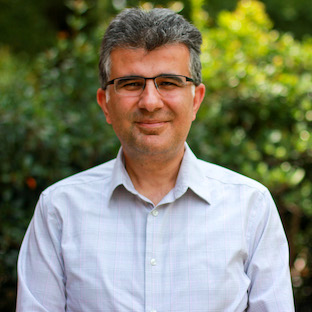Unlocking Forest Vital Signs: Harnessing Microwave Remote Sensing with a Unified BERT Radiative Transfer Theory
The Atlanta chapters of AES/GRS, IM/EMC, and AP/MTT are pleased to host Dr. Mehmet Kurum on Wednesday, December 4. The talk will be held in Midtown Atlanta, streamed to Cobb County, and available virtually via Webex.
Speaker: Dr. Mehmet Kurum, Associate Professor at the University of Georgia
Title: Unlocking Forest Vital Signs: Harnessing Microwave Remote Sensing with a Unified BERT Radiative Transfer Theory
Abstract: Variations in forest vegetation water content (VWC) indicate forest health and resilience to stresses like temperature changes, water availability, and disturbances. Vegetation optical depth (VOD), derived from microwave retrievals, is proportional to forest VWC, and can act as a health monitor for ecosystems. Improved temporal and spatial quantification of VWC variations is expected to aid in the improved evaluation of how forests respond to drought, including tree mortality and wildfire risk. However, current spaceborne VOD products struggle with the lack of physical relationships between geophysical properties and radiative transfer characteristics, especially given the temporal variability and spatial heterogeneity. VOD estimates are influenced by various factors that need to be corrected and taken into account, including structure information, vegetation sap, and water film layers in addition to microwave parameters like polarization and frequency.
In this talk, I provide insights into the parameterization of retrieval algorithms and deepen the understanding of VOD across a broad spectrum of microwave measurements, such as Backscatter, Emissivity, Reflectivity, and Transmissivity (collectively referred to as BERT). We demonstrate integrating Light Detection and Ranging (LiDAR) measurements within a novel unified radiative transfer (RT) framework to simulate forest BERT (ForBERT) observations. Such a unified model will aid in analyzing and interpreting VOD data from various NASA missions like SMAP, CYGNSS, AMSR-2, and future NISAR, as well as ESA missions such as SMOS, Sentinel-1, and ASCAT.
We will explore needs in scattering models with varying degrees of assumption on the statistical homogeneity, the shape of scatterers, wave illumination, and complex heterogeneous realistic vegetated terrains. In other words, we seek “radio realistic” scene generation by exercising the trade-off between “photo” (architecture) realism and accuracy needs. Without a clear understanding of the impact of the complex features of a “radio realistic” canopy on the scattered signals, retrieval algorithms cannot make the best use of retrieved VOD measurements or can even cause misinterpretation of the results.
Date and Time
Location
Hosts
Registration
-
 Add Event to Calendar
Add Event to Calendar
Loading virtual attendance info...
- 950 Atlantic Dr NW
- Atlanta, Georgia
- United States 30332
- Building: EBB Krone
- Room Number: 4029
- Starts 18 November 2024 05:00 AM UTC
- Ends 03 December 2024 04:59 AM UTC
- No Admission Charge
- Menu: Midtown In-Person, Cobb In-Person, Virtual
Speakers
Dr. Mehmet Kurum
Unlocking Forest Vital Signs: Harnessing Microwave Remote Sensing with a Unified BERT Radiative Transfer Theory
Biography:
Dr. Mehmet Kurum received his B.S. degree in Electrical and Electronics Engineering from Bogazici University, Istanbul, Turkey, in 2003, followed by his M.S. and Ph.D. degrees in Electrical Engineering from George Washington University, Washington, DC, USA, in 2005 and 2009, respectively. He held Postdoctoral and Research Associate positions with the Hydrological Sciences Laboratory, NASA Goddard Space Flight Center, Greenbelt, MD, USA. From 2016 to 2022, Dr. Kurum served as an Assistant Professor at Mississippi State University, and subsequently, he held the position of Associate Professor and the Paul B. Jacob endowed chair until 2023. Currently, he is an Associate Professor in the School of Electrical and Computer Engineering at the University of Georgia.
Dr. Kurum’s research involves microwave remote sensing from satellite scales to small aerial platforms in environmental sustainability. His current research focuses on changing the paradigm of microwave remote sensing methods and developing next-generation technologies and ideas that are more spectrum efficient, more effective and meet the challenges of the present and future spectrum congestion. His portfolio encompasses development of retrieval algorithms and forward EM model simulations in support of the NASA’s SMAP, SNOOPI, NISAR, and CYGNSS satellite missions. He has previously served as the principal investigator on a multitude of research grants funded by federal agencies such as DOD, NASA, NSF, and USDA.
Further info: https://impress.engr.uga.edu/
Agenda
11:30 - noon : Lunch
Noon - 1:00 : Technical Talk
Two physical locations will offer lunch at 11:30 AM. Please indicate in the RSVP menu options which site you will attend, or if you will attend virtually.
Midtown Atlanta (In-Person):
Georgia Tech EBB Krone Building, Room 4029
950 Atlantic Dr NW Suite 1
Atlanta, GA 30332
Cobb County (Virtual):
GTRI Building 11, Rm 1226
2001 Dixie Avenue SE
Smyrna, Georgia 30080


